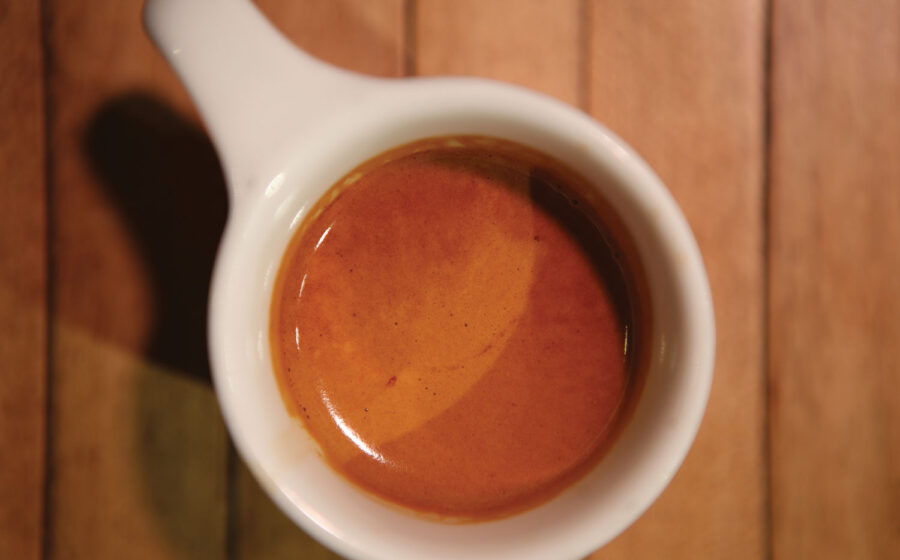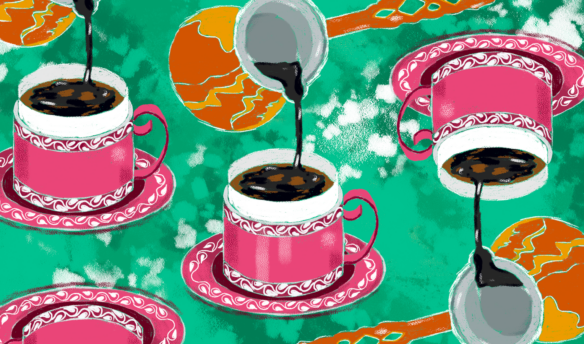[W]hile finicky espresso may be considered by some to be the epitome of coffee extraction, it’s the drink’s aesthetic nature that gives it class. Crema, both aromatic and easy on the eyes, draws the drinker in. For this reason, being able to produce thick, lasting, and unbroken crema has for years been considered a barista’s ace in the hole. But there’s more to espresso’s top layer of foam than many realize.
Notoriously difficult to perfect, espresso is a drink that invokes strong opinions. There are those who tout crema for its powerful aroma and body, labeling it a major player in the espresso experience. But more baristas are disputing the accuracy of the notion that crema is an indicator of quality. Still others disregard crema entirely, choosing instead to remove it prior to serving. Crema’s role is controversial, yet indivisible from espresso’s legacy and flavor. As Ken Nye—owner of Ninth Street Espresso in New York—puts it, “It’s a very potent little thing.”
First, let’s generally define foam as gas bubbles dispersed in a liquid. In espresso, that gas is carbon dioxide created during the roasting process. While roasters look for sweetness, balance, and flavor in a finished product, they also consider how their beans perform going through a machine. So crema plays a role in defining the perfect roast.
“Dense, sweet beans will retain carbon dioxide longer,” says Brandon Smyth, part-owner and roaster at Water Avenue Coffee Company in Portland. “Especially if there is any pectin left from the processing, as with a honey, pulped-natural, or machine-washed coffee.”
When that carbon dioxide eventually breaks free in contact with hot, high-pressure water, it yields a bubbling foam: the crema. As Smyth notes, different kinds of coffees and different roast profiles produce different off-gassing, and crema is affected by factors as wide-ranging as region and roast date. “If I need more crema, sometimes I’ll adjust the percentage of varietals in the blend,” he says. “A high-altitude bourbon or typica will usually do the trick.”
Behind the bar, each step of espresso preparation influences the outcome of the crema. Erica Soule, master barista and trainer at Water Avenue, says, “We’re using a whole catalog of tools while we pull espresso to know that it is going to be great without having to taste it. We watch for when it drops, how it drops, how long it takes before it forms a stream, what that looks like… That final visual assessment by default includes crema.”
In a sense, a barista is a scientist, too. They must consider weight, volume, temperature, pressure, and fluid dynamics to extract perfectly, and mastering this process is no easy feat. “If you don’t make your espresso properly, if you’re not careful, a lot of bad things can happen in that little cup,” says Nye at Ninth Street. “And a lot of it comes from the compound that’s sitting on the top.”
Coffee, when you zoom way in, is an emulsion of microscopic droplets of oil and water mixed with all sorts of other goodness (caffeine, sugars, acids). The oils in coffee, just like any other oil, cannot dissolve in liquid. This contributes to espresso’s layered nature. Furthermore, anyone who enjoys proper espresso certainly has a keen awareness of the instability of crema. Eventually, the foam dries and dissipates, exposing the liquid coffee beneath. Baristas traditionally aimed at producing thick, mahogany-colored crema that takes time to disappear.
Today, traditions are being questioned or even ignored. As more roasters move away from traditional espresso roasts designed to play well with milk in order to explore new flavors in espressos made from micro-lot and single-origin coffees, expectations for crema are evolving, too. “Some of the rigid guidelines, like color and volume or the old-fashioned notion that robusta produces crema, are being replaced with judgments based on the end-of-the-day results from coffees not usually equated with espresso, like a natural Maracaturra,” says Smyth.
Ignoring this shift in the views of espresso is to ignore new and exciting coffees, an inequality that frustrates Soule. “Crema is not that important to me,” she says. “I’m looking for a tasty espresso. That’s something that has acidity, sweetness, body, and a nice finish.” Refusing to let things be too simple, she adds, “however, taste is also subjective and influenced by another sense: sight.”
—Regan Crisp is Fresh Cup’s associate editor.
















